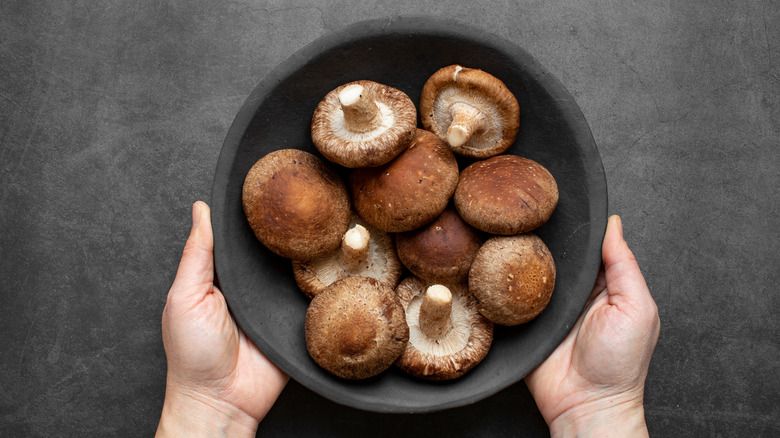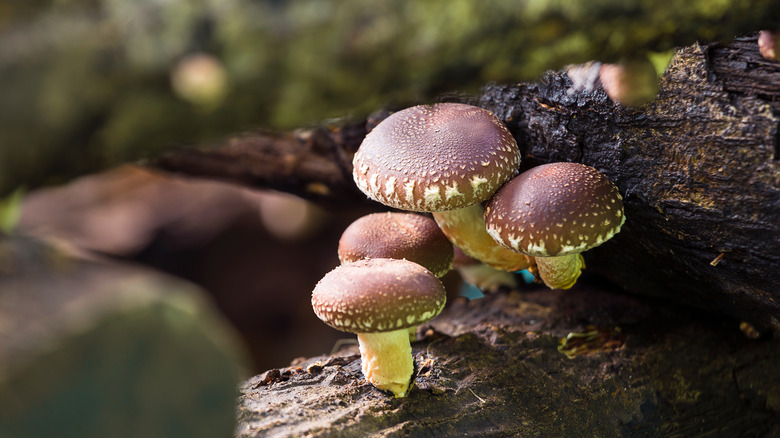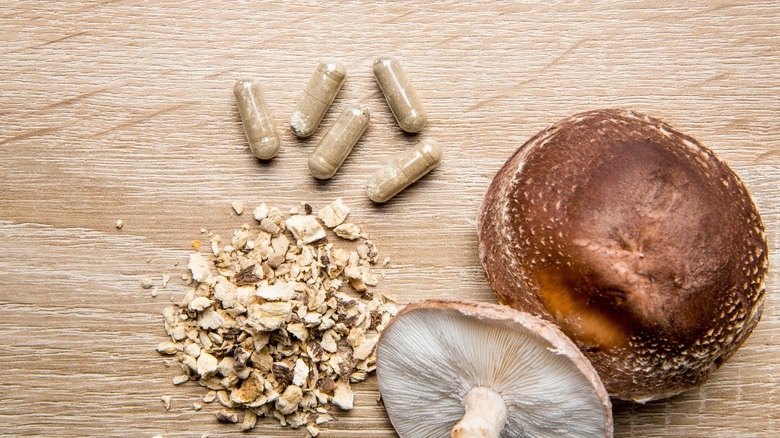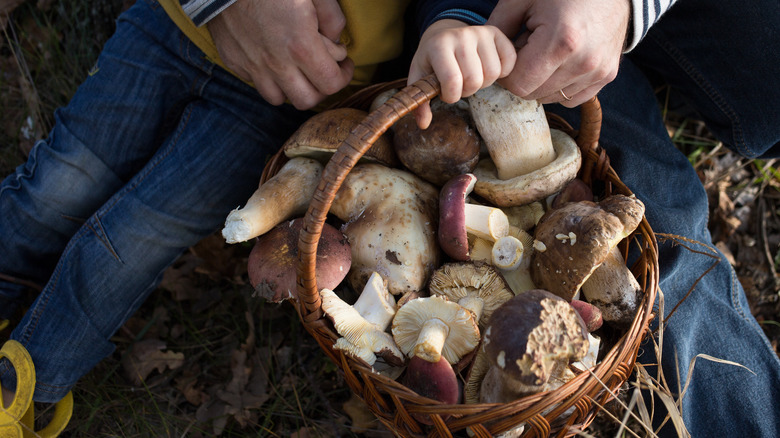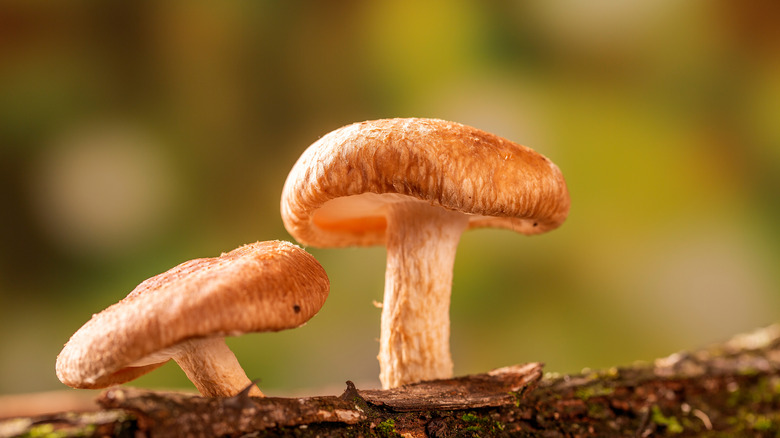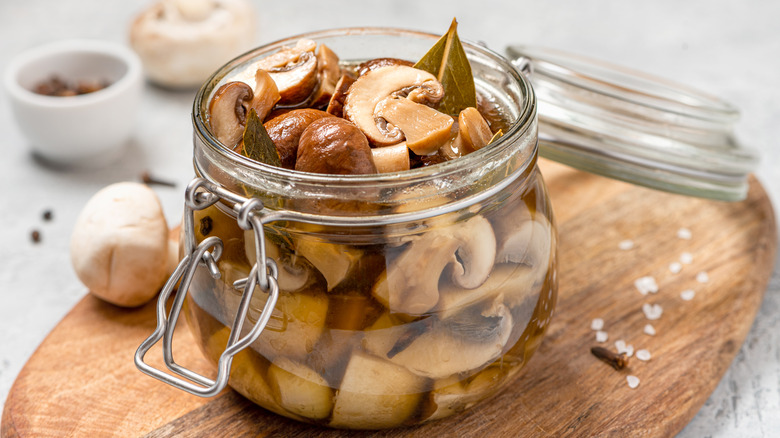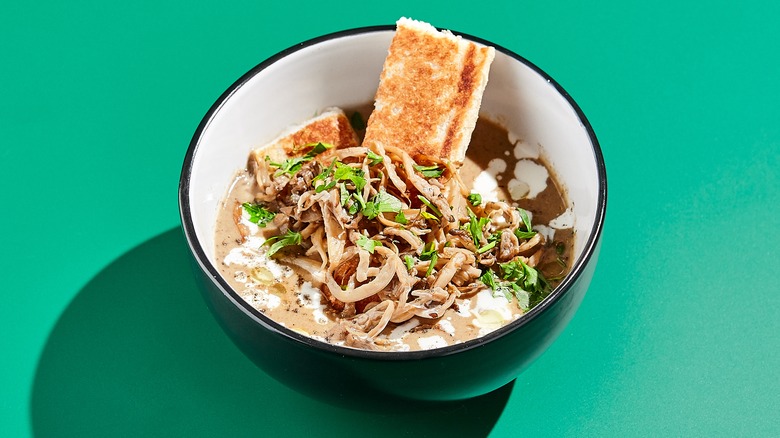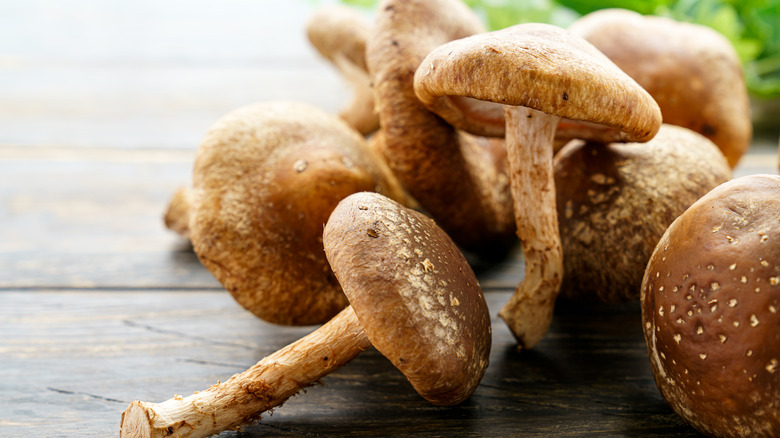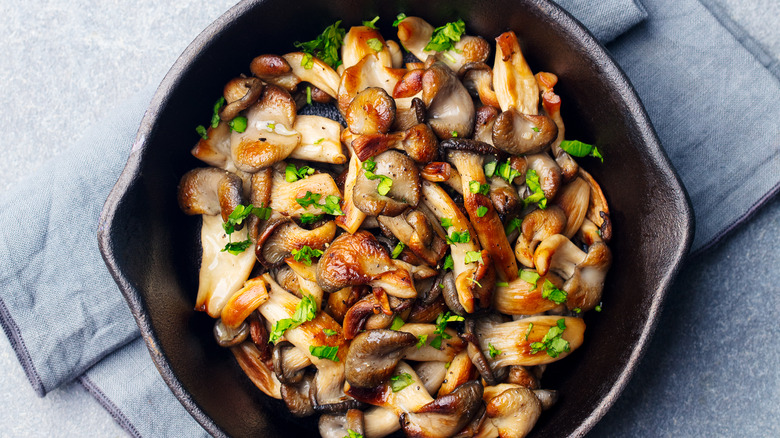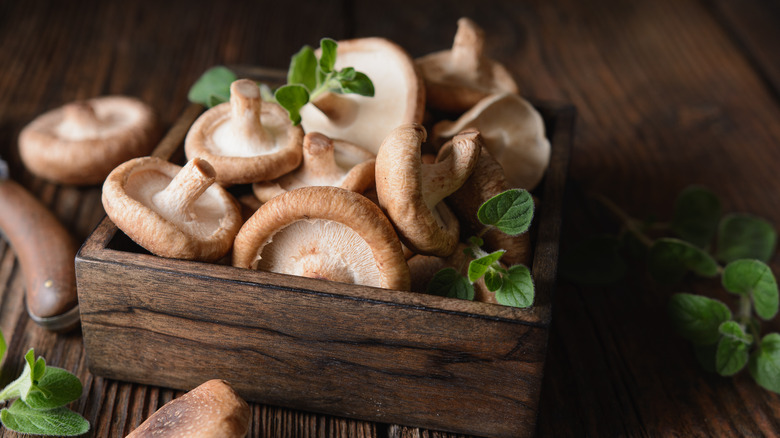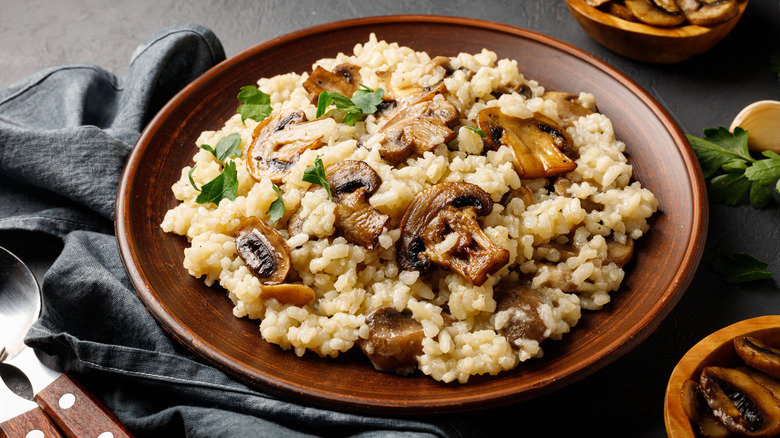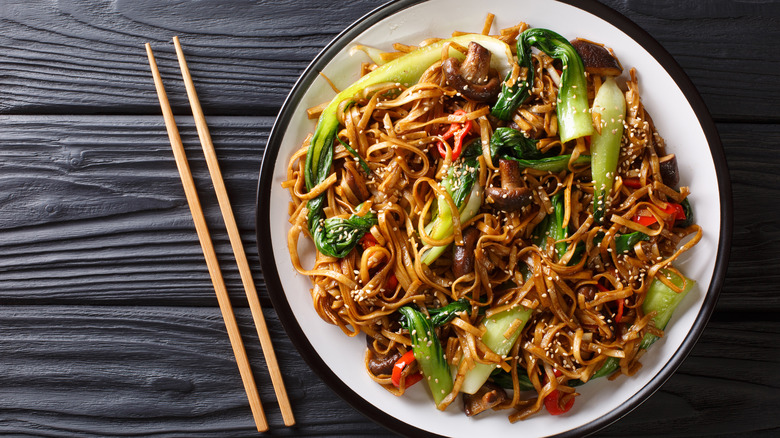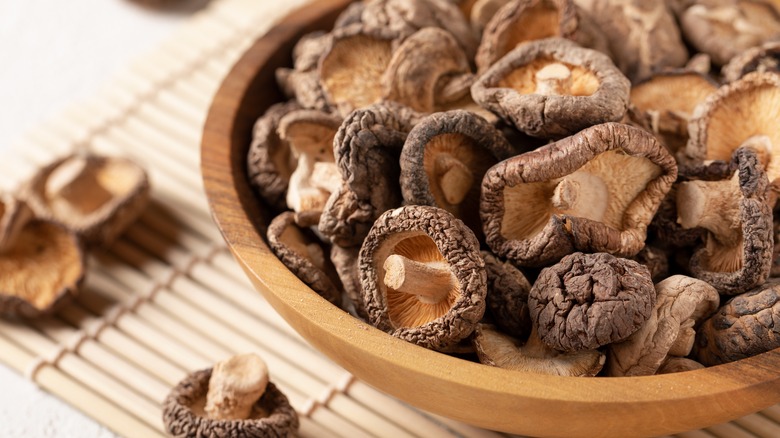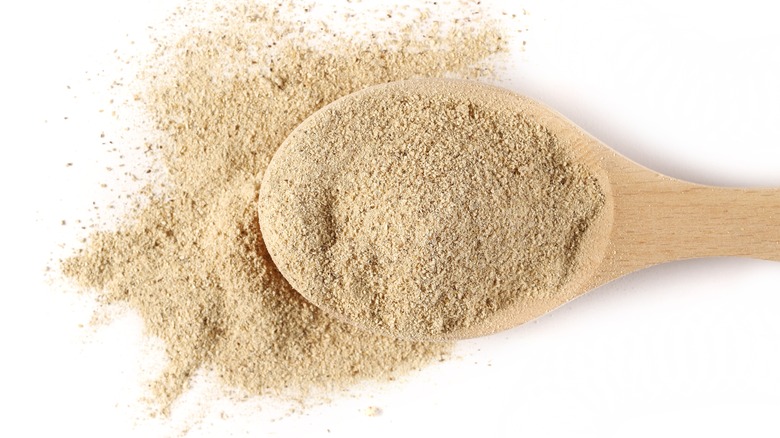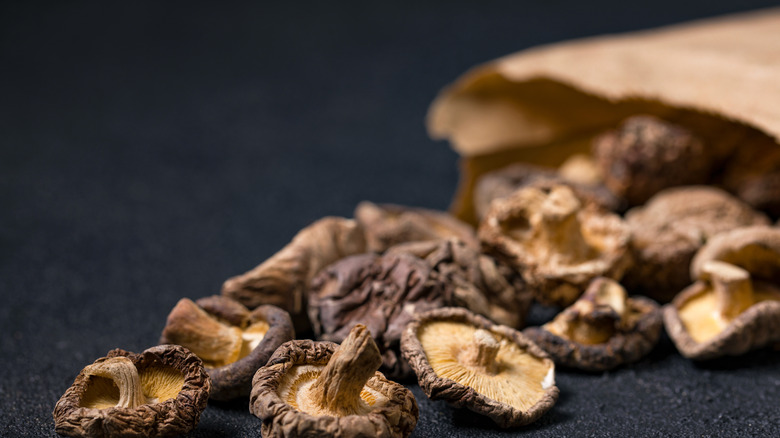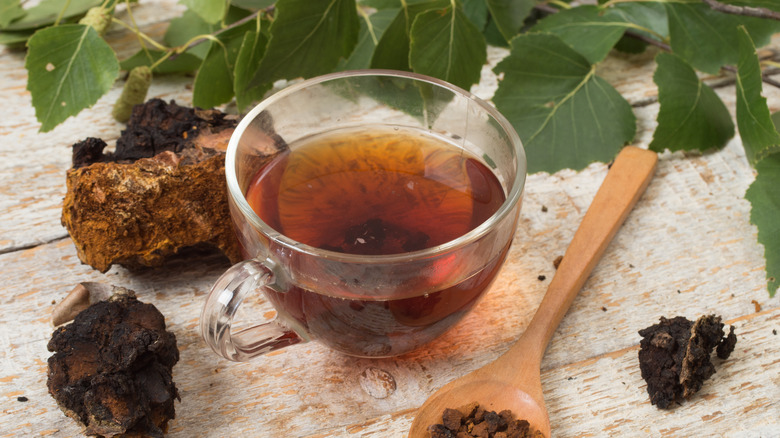Everything You Need To Know About Shiitake Mushrooms
We may receive a commission on purchases made from links.
Depending on your culinary background, shiitake mushrooms may seem either exotic or mundane. For some chefs, shiitakes might be just another mushroom, easily swapped for crimini or porcini mushrooms, depending on what's available. To others, they may seem like a strange and even intimidating ingredient, something to be avoided in the grocery store in favor of simpler white button mushrooms.
The truth is, wherever you currently fall on the spectrum, there really is a lot to shiitakes. It's not just their ubiquity, nutritional value, or versatility in recipes that you should be aware of. Fundamentally, shiitakes are almost a cooking staple and really are one of those foods that every chef should have a firm handle on. Learning more about this mushroom may allow you to diversify your culinary habits, try exciting new recipes, and, potentially, help guide you to even more exotic and delicious foods.
With that in mind, we put together everything you need to know about shiitake mushrooms.
Shitakes are native to East Asia
Shiitakes are often associated with Japanese and other East Asian cuisines, and for good reason: Shiitakes are native to East Asia, and can actually still be found growing wild in China, Japan, and other parts of the continent. In fact, their cultivation by humans dates back centuries: According to Clark University, Chinese growers first began domesticating shiitakes between 1000 and 1100 A.D.
Not surprisingly, the mushroom is known by a few names in China and Japan. The Mycological Society of San Francisco writes that it is known as dongo and shanku in China, while in Chinese restaurants in the United States, it is sometimes called "the black forest mushroom." Even though they are the same type of mushroom, the meatier and smaller shiitakes are called donko in Japan. The larger variety that matures until spring is called koshin.
Whatever you call them, it is undeniably impressive (and a testament to the quality) that this mushroom has been so popular for roughly a millennium — including, and increasingly, in the West. In fact, the shiitake mushroom is one of the most cultivated edible mushrooms in the world.
Shitake mushrooms are packed with vitamins
Part of what has historically made shiitakes so popular is their nutritional value. Encyclopedia Brittanica says shiitakes have traditionally played an important role in Asian medicine, and, perhaps, this stems from their vitamin content: They are notably high in several different minerals, including B vitamins, copper, selenium, manganese, and iron.
If that's not impressive enough, recent studies actually suggest that shiitakes might have even more advanced health benefits. According to Healthline, shiitakes may be good for your heart: Eritadenine, sterols, and beta-glucans in mushrooms can help lower cholesterol. Shiitakes may also offer immune support, potentially due to the polysaccharides found in the mushrooms, according to Healthline, while other benefits (all of which require further study in humans) suggest that shiitakes might have anticancer, antibacterial, and antiviral effects, and could even support bone health.
All in all, these are some pretty substantial side benefits to have along with a delicious and versatile ingredient!
Shitakes consume dead wood
When you think of something appetizing, the word "fungus" may not come to mind. But, like all mushrooms, shiitakes are indeed a type of fungus. They are more specifically a member of the family Marasmiaceae and order Agaricales. They are not just interesting to look at and delicious to eat. Like many other types of fungi, shiitakes play an important role in different ecosystems by consuming dead wood. This behavior is crucial for saprotrophs like shiitakes, which are organisms that consume dead organic matter and help to recycle important nutrients, particularly in forest ecosystems. Shiitakes, specifically, consume the dead wood of oaks and similar trees.
Of course, this is essentially their wild role; shiitakes grown directly for consumption are cultivated differently. In this case, per Encyclopedia Brittanica, they are typically grown in ways that approximate their natural habitat — for instance, on logs, sawdust blocks, or pellets.
Shitakes can be grown at home with a kit
If you have the time and inclination, it is actually not particularly hard to grow your own supply of fresh shiitakes at home. Many commercial operations use logs, as well as sawdust-based products, to approximate the forest environment in which shiitakes traditionally grow. While this is often done on a massive scale, it can be done on a much smaller scale right in your home.
You can find plenty of mushroom-grow kits online. One company that supports mushroom cultivation, Field and Forest Products, explains that the process is best followed carefully and requires a starter kit, but essentially amounts to cutting (or purchasing) fresh logs, properly inoculating the logs with shiitake spawn, and then allowing logs to incubate in a properly moist environment. After five months to a year, you can find yourself harvesting and cooking with your own fresh mushrooms!
Mushrooms are great pickled
Ever tried mushroom pickles? They're not exactly as common as dill spears or bread-and-butter pickles, but mushroom pickles are indeed a real thing, and can make a great topping or side dish for a wide range of foods.
How do you use them? A pickled mushroom toast recipe offers a good starting point. While the recipe calls for black trumpet and maitake mushrooms, shiitakes can make a suitable substitution. Like most basic pickling recipes, this one calls for mixing sugar, water, and vinegar (in this case, white wine vinegar) into a pickling liquid. Notably, though — and unlike most typical "quick pickles" — the recipe calls for letting the pickling liquid cool before pouring it over the mushrooms. This is a good rule of thumb if pickling shiitakes as well; mushrooms are much more sensitive than, say, cucumbers, and a hot pickling solution might be damaging to the mushrooms.
This pickled delicacy will go well on toast with mushroom blanquette, but they're also a pretty exciting topping to keep in the fridge and try out in or alongside all sorts of meals.
Shitakes are delicious in soup
You can't talk about shiitakes without talking about soup. Shiitake mushrooms are delicious as a starring ingredient. They have a lot of body and can function as a meaty centerpiece of many soups, particularly those with Chinese or Japanese-inspired flavors, like a tasty shiitake mushroom soup with tofu, bok choy, and miso paste.
But, shiitakes can also be used in soups in another way: They can serve as the basis for a rich shitake mushroom vegetable broth. This particular type of broth — known as dashi — is important in Japanese cuisine, but by making your own you can almost certainly find a variety of uses. The vegetable broth uses shiitakes, a variety of herbs including thyme and parsley, garlic, onion, leek, and other ingredients to create a rich base that can be used in all sorts of dishes. Perhaps best of all, the slow simmering process will help the broth fully absorb the rich flavor and substantial nutritional content in the mushrooms.
Stems should be saved
Many chefs, either by habit or training, tend not to use mushroom stems. Some might not like the texture, which tends to be less appetizing than the mushroom cap, and others might do it for simple aesthetic purposes. Whether you like to eat mushroom stems or not (and plenty of people do!) it is important to note that shiitake stems are indeed edible and can be enjoyed. If the whole stem is a little too much, consider chopping it up into smaller pieces to make it more digestible.
But, even if you decide to eschew stems, they can still serve plenty of other uses in your kitchen. The stems can be used fresh in mushroom broth or as a flavoring in other soups; they can also be dried or frozen and used in much the same way in the future. Alternatively, they can be dried and ground or crushed into a powde to be used as a unique seasoning in future dishes.
Mushrooms are tasty when roasted
Soups are one popular way to enjoy shiitakes, but roasting mushrooms in the oven is another. Perhaps surprisingly (given that they are fairly delicate) shiitakes do quite nicely in the oven. They may shrink a little but also get a nice and chewy texture (sometimes even a little crispy, depending on their size). Marinades and glazes can also go a long way toward giving mushrooms extra flavor as they bake and help them avoid drying out.
Because they are not as big as portobello mushrooms, shiitakes tend to be relegated to a supporting role in the oven. But, that's okay. They can more than adequately complement the flavors or any number of dishes. For instance, shiitakes play a prime role in a one-tray roasted salmon recipe. Shiitakes are tossed with red pepper, peas, and bok choy, and seasoned with oil, salt, and pepper. The whole dish is cooked in a single pan with sesame, soy sauce, and honey-glazed salmon.
Shitakes are potentially hazardous if eaten uncooked
It is no secret that mushrooms can have all kinds of effects on the human body: Some are delicious and highly nutritious, others produce psychoactive effects, and still, others are poisonous to varying degrees. Sometimes, of course, these categories can slightly overlap. Shiitakes aren't poisonous, and given that they are typically bought in a grocery store, they are generally quite safe. Of course, if you do happen to go foraging somewhere in Asia where shiitakes grow wild — or for that matter, go any foraging for edible mushrooms — it is important to be extremely cautious in correctly identifying what you pick.
This said shiitakes are sometimes associated with an uncomfortable skin rash called shiitake dermatitis. Not many people are sensitive to the compound called lentinan, which causes the rash; moreover, lentinan is not a problem once shiitakes are cooked. But, it's important to be aware that if you do ingest raw shiitakes, they could potentially cause some skin discomfort.
Add as an ingredient for a rich risotto
Mushrooms can be great in risotto dishes and shiitakes are no exception. The rich, hearty, almost-meaty texture of the shiitakes can serve as a focal point in risotto dishes, complementing the creamy rice and pairing nicely with a wide variety of flavors. For those new to the dish, risotto is a rice-based dish of Italian origin, typically cooked with butter, cheese, and a rich cooking liquid, like chicken broth, to produce a creamy finished product. Risotto is frequently made with arborio rice, but if that is not available, another short-grain rice will usually work well enough.
There are all sorts of risotto dishes: A fairly simple parmesan risotto, delicious (and a little pricey) lobster risotto, and really anything else you can conceive of, once you get the basic idea for the recipe. Shiitakes work especially well in a homemade mushroom risotto recipe, where they are complemented by garlic and flavorful thyme.
Shitakes are essential in stir-fries
Shiitakes, of course, are a mainstay in Chinese and other East Asian cuisines, and accordingly, they often have a prime role in stir fries. Stir fries are by now pretty common but are great for those still honing their kitchen chops. Notably, the original Cantonese meaning of the term stir-fry suggests "tumbling" vegetables — not "stirring" them — to evenly and lightly sear everything in the pan. Mushrooms like shiitakes will typically be added after thicker and heartier ingredients, like broccoli or cauliflower.
Fortunately, maybe the best thing about stir fries is that they are extremely adaptable. Substituting different types of meat (or meat substitutes, like tofu), veggies, and even cooking oils, sauces, and pans can help you find your own preferred method of making the dish. If you're looking for somewhere to start, and want to incorporate tasty shiitakes, try a stir-fry with shirataki noodles, which are light, translucent Japanese noodles, and are a particularly good choice for people with dietary restrictions.
Mushrooms are an excellent meat substitute
While shiitakes pair quite nicely with meat and fish dishes, such as in a mushroom steak sauce, they can, like many other mushrooms, also be very effectively substituted for meat in plenty of recipes. The rich flavor and hearty texture of shiitakes make them a particularly good choice.
In some cases, the substitution does not even have to be "intentional." For instance, you can make a stir-fry and simply let the shiitakes play the starring role instead of some type of animal protein. But, shiitakes can also make a direct substitution for meat in more complex recipes. While King Oyster mushrooms have been described as a close flavor substitute to chicken, shiitakes are also fairly similar.
If you're looking for more of a red meat substitute, shiitakes can also play a role: While larger portobello mushrooms are the classic substitute for burgers, finely chopped shiitakes can play a role in a vegetarian ground beef substitute. In fact, they can even be used to make a wholly vegetarian "meatloaf" recipe.
Shitakes work well dried
Shiitake mushrooms are probably most often used fresh, and these days, they are readily available at many grocery stores. While fresh shiitakes are great, the mushrooms can also easily be used when they have been dried. It's not difficult to come across dried mushrooms. They can easily be made on your own, at home, using an oven or dehydrator; they can also be purchased at many specialty grocery stores. Dried mushrooms are convenient because, unlike fresh mushrooms, you can store them in an essentially shelf-stable way. This saves space, allows you to can use them when you want to, and for easy use in most recipes that call for mushrooms. Try a recipe for mushroom steamed buns or vegetarian mapo tofu.
You can also use dried shiitake mushrooms in another way. By grinding and making a mushroom powder. This can make a fun umami seasoning to experiment with in all sorts of recipes.
Shitakes must be stored carefully
Despite their versatility when dried, it is no secret that for many chefs, there is nothing better than fresh mushrooms. While it is not exactly difficult to keep mushrooms fresh for a while, it does take a little extra consideration to be sure that they do not spoil too quickly. This may be especially important when it comes to shiitakes, which can be pricier than some other types of mushrooms.
Fresh shiitakes can be stored in a few ways, but in general, it's important to keep them cool in the fridge. If they come in their own packaging (typically plastic wrapped) be sure there are some holes to let the mushrooms breathe. Otherwise, they can get overly moist, and may end up spoiling quickly.
If the mushrooms are loose — or are removed from their original packaging — the best way to store them is wrapped in a paper towel, inside an open paper bag. The paper can absorb some moisture while letting enough of it escape, ensuring your mushrooms do not get wet and funky. For best results, avoid the fridge's crisper drawer, which may keep them too moist.
Mushroom can be brewed
Ever heard of mushroom coffee? It has become increasingly popular in recent years as an alternative or amendment to coffee. In many versions of the beverage, ground mushrooms are combined with ground coffee beans to add an earthy flavor and to obtain any number of health benefits, ranging from improved digestion to stress reduction. While lion's mane, chaga, and reishi mushrooms are considered superfoods and are among the most typically used in mushroom coffee, there is no reason why you can't experiment with dried shiitakes.
Mushroom tea is also popular in some circles. Per Everyday Health, mushroom tea has a few similar health benefits, potentially improving gut health and helping to regulate blood sugar. Prepared mushroom tea blends can increasingly be found in stores, but it is also possible to make your own by using dried and steeped mushrooms in hot water, either on their own or with other tea or flavors added.
